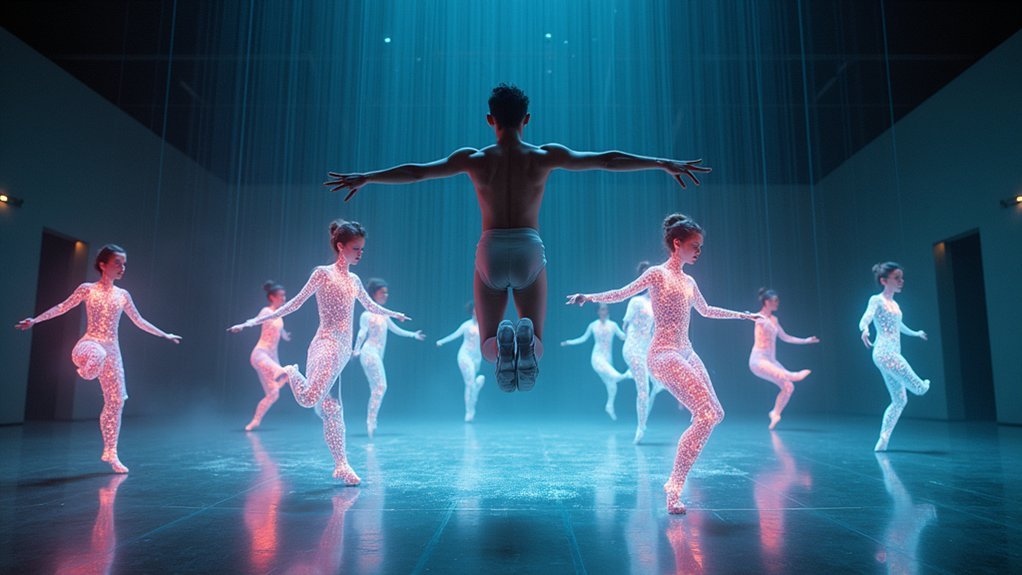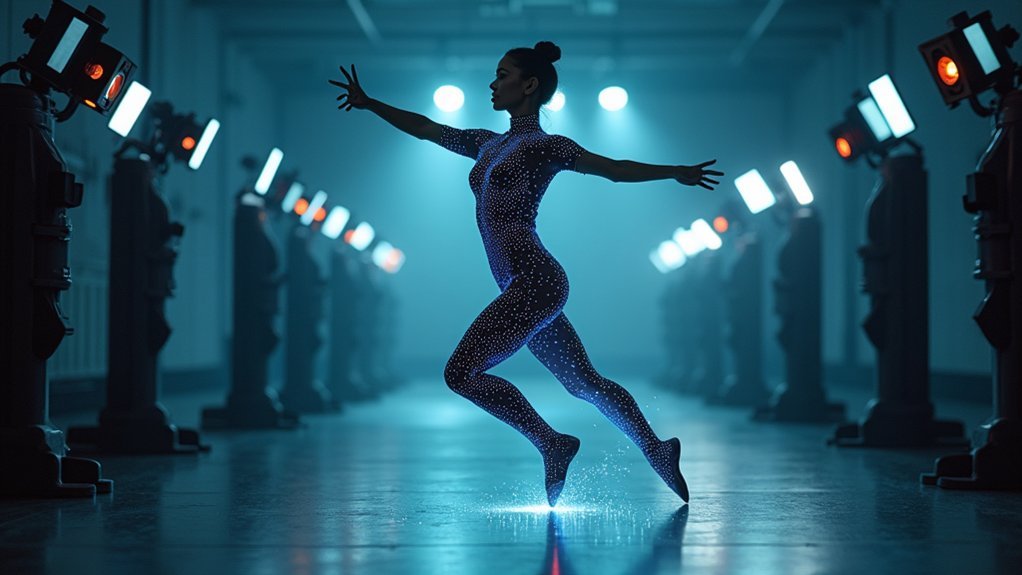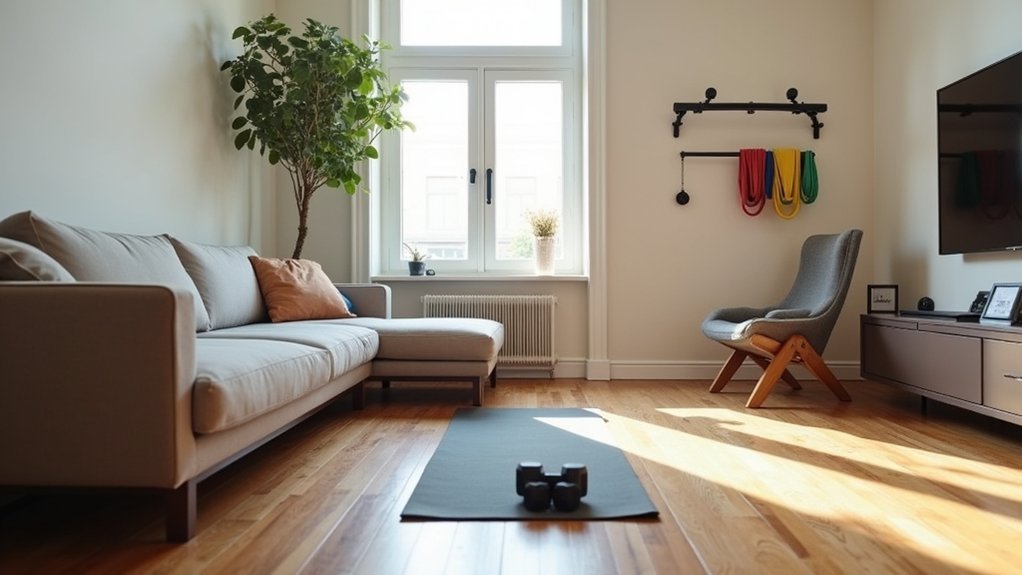Full-body motion tracking revolutionizes digital interaction by capturing your entire physical movements in real-time. This technology transforms how you engage with virtual environments, control devices, and communicate in digital spaces—all without traditional controllers. With error rates as low as 1.4°, systems now track subtle gestures and postures that enhance immersion and accessibility. From therapy to industrial applications, motion tracking bridges physical and digital worlds in ways that once existed only in science fiction. The journey from fantasy to everyday reality has just begun.
From Sci-Fi to Reality: The Evolution of Motion Tracking
While science fiction once portrayed motion tracking as a futuristic fantasy, the technology’s roots stretch back more than a century. Eadweard Muybridge’s pioneering work in the late 1800s established the foundation for capturing movement, evolving into the rotoscoping techniques of the 1920s that allowed animators to translate live action into animation.
The first true breakthrough came in the 1950s when Lee Harrison III developed the world’s first motion capture suit, enabling real-time recording of actor movements. Modern systems have revolutionized the field by using various tracking methods including reflective markers that identify body landmarks and precisely track three-dimensional motion of body segments.
Breaking Free From External Hardware: The Mobile Revolution
You’re now carrying advanced motion capture studios in your pockets, as today’s smartphones, watches, and earbuds pack accelerometers, gyroscopes, and magnetometers that track your every move.
These everyday devices fuse sensor data through machine learning algorithms to deliver real-time, full-body tracking without external cameras or specialized equipment.
You’re free to move anywhere while maintaining accurate tracking, transforming activities from gaming to fitness coaching without the constraints of designated spaces or expensive hardware setups. Northwestern engineers’ MobilePoser system achieves impressive tracking with only an 8 to 10 centimeter error rate, making it highly competitive with traditional systems.
Pocket-Sized Motion Capture
As technology continues to shrink in size, motion capture systems have followed suit, creating a revolution in how we track human movement.
You’ll find these portable systems eliminate the need for specialized equipment, letting you capture motion anywhere without bulky hardware or marker suits.
With AI-driven software analyzing body movements in real-time, you’re free from traditional constraints. Your performers can move naturally while delivering authentic performances that translate seamlessly into high-quality animation data. These systems promote more natural performances without the physical restrictions that traditional motion capture suits often impose.
The cost benefits are substantial—you’ll spend less on equipment while streamlining your workflow. Setup takes minutes instead of hours, making motion capture accessible even for independent creators and small studios.
Whether you’re developing games, creating VR experiences, or producing animations, these pocket-sized solutions offer professional-grade results without the traditional complexity and expense.
Sensors Everywhere
The revolution in motion capture technology lies in the hidden world of sensors surrounding us daily. Your smartphone, smartwatch, and even wireless earbuds contain sophisticated IMUs capable of tracking precise movements without specialized equipment.
This sensor ecosystem eliminates bulky hardware and dedicated capture rooms. By combining data from multiple devices you already own, you’re creating a thorough motion capture system in your pocket.
Physics-based algorithms and machine learning work together to interpret this sensor data, enforcing biomechanical constraints that guarantee accuracy. Users can see that the system is actively processing their movements as feedback indicators appear during calibration phases.
The result? Real-time, full-body motion tracking that processes immediately on your device, providing instant feedback without privacy concerns.
This democratization of motion capture technology means you can track movements anywhere, anytime—transforming applications across gaming, fitness, healthcare, and entertainment industries.
Untethered Spatial Freedom
Breaking free from external cameras and designated spaces, today’s motion capture technology has entered a new era of untethered spatial freedom. You’ll experience unrestricted movement using magnetic field sensors that track your motions without visual line-of-sight constraints. With a 100m tracking range, you can perform motion capture outdoors without requiring dedicated spaces.
| Feature | Benefit |
|---|---|
| Magnetic Tracking | Move freely without optical constraints |
| Wireless Connectivity | Eliminate restrictive cables with Wi-Fi/Bluetooth |
| Lightweight Materials | Enjoy extended comfort during active sessions |
Advanced algorithms mitigate interference while maintaining submillimeter accuracy, ensuring your movements translate precisely to digital environments. This technology isn’t just revolutionizing entertainment—it’s transforming biomechanics research, prosthetic control, and therapeutic applications. With dual-mode connectivity and real-time data streaming, you’re no longer bound to specialized studios or limited spaces—your full range of motion can be captured anywhere.
How AI and Machine Learning Transform Body Movement Capture
You’ll find AI algorithms dramatically improving motion tracking accuracy by filtering sensor noise and predicting joint positions beyond what raw data alone can provide.
Real-time pose prediction lets your movements appear fluid and natural in digital environments, even when using minimal sensors on a smartphone.
The most advanced systems continuously learn from your unique movement patterns, adapting to your gait, posture, and motion signatures for increasingly personalized tracking performance.
These advancements build upon traditional methods like the Lucas-Kanade Method, which established fundamental optical flow techniques for tracking movement across video frames.
AI-Enhanced Motion Accuracy
While traditional motion tracking systems struggled with precision in complex environments, AI and machine learning have revolutionized how we capture body movements.
These technologies now enable you to track motion with unprecedented accuracy in real-time, regardless of lighting conditions or background clutter.
Deep learning enhances your tracking capabilities through:
- Advanced feature detection that identifies facial landmarks, limb positions, and clothing textures
- Markerless tracking that eliminates the need for physical sensors, making the technology more accessible
- Multi-object handling that simultaneously tracks multiple bodies, even those moving unpredictably
- Real-time processing that delivers immediate insights with minimal lag
The neural networks powering these systems continuously improve through exposure to diverse datasets, ensuring robust performance across various environments. Recent mobile applications have demonstrated compatibility with professional motion capture systems while offering more accessible and cost-effective solutions for clinical use.
Real-Time Pose Prediction
As AI and machine learning algorithms continue to evolve, real-time pose prediction has emerged as a transformative technology in motion capture systems.
You’ll witness these systems achieving up to 46 FPS without rendering, nearly matching 2D models that produce keypoints at approximately 50 FPS.
Advanced neural networks and physics-based optimization now enable your devices to understand and predict human behavior with remarkable speed.
Whether you’re developing autonomous vehicles that anticipate pedestrian movements or creating fitness applications that offer instant form correction, real-time tracking changes everything.
The integration of sensor data from everyday devices like smartphones and smartwatches makes this technology increasingly accessible.
Though challenges remain in complex scenarios like dim lighting, these systems effectively handle standard environments, revolutionizing industries from healthcare to gaming.
Developers can leverage pretrained models that excel in specific human pose estimation tasks, significantly reducing development time while maintaining high accuracy.
Continuous Self-Learning Systems
Real-time pose prediction sets the stage for an even more sophisticated advancement: continuous self-learning systems.
These AI-driven frameworks transform motion capture by constantly improving their understanding of your movements without manual intervention.
The Tracking-Learning-Detection (TLD) framework exemplifies this approach, combining immediate tracking with adaptive learning mechanisms that correct errors automatically. These systems use tracking-by-detection algorithms that efficiently link object detections to existing trajectories across video frames.
Deep learning algorithms enhance these systems by extracting complex spatial and temporal features from your movements.
- P-N learning identifies both missed detections and false positives, continuously refining tracking accuracy
- Self-supervised mechanisms adapt to your unique movement patterns without requiring new labels
- Adaptive correction loops prevent misclassifications from propagating through the system
- Drift mitigation techniques maintain performance integrity during extended capture sessions
You’ll experience more natural interaction as these systems learn your movement style over time.
Democratizing Motion Tracking: Affordability and Open-Source Solutions
Despite the historically high costs of professional motion capture systems, recent innovations have dramatically changed the accessibility landscape for full-body tracking technology. You can now experience full-body tracking for as little as $185 with SlimeVR, without needing expensive base stations or camera systems. SlimeVR trackers utilize IMU technology for absolute rotation tracking, making them immune to occlusion issues.
| Solution | Price | Key Features |
|---|---|---|
| SlimeVR | $185+ | Open-source, no base stations |
| PICO Motion Tracker | ~$60 (2 trackers) | Budget-friendly, versatile |
| Sony mocopi | $449.99 | Streamlined system |
| Xsens MVN Awinda | Higher cost | Extensive wireless |
| DIY Options | Variable | Customizable, community-supported |
The open-source nature of solutions like SlimeVR extends beyond affordability, allowing you to customize, modify, and even build your own trackers, fostering an innovative community where users continuously improve the technology together.
Beyond Gaming: Industry Applications Transforming Work and Play
While gaming often captures the spotlight in motion tracking discussions, the technology’s reach extends far beyond entertainment. Full-body motion tracking is revolutionizing industries from manufacturing to healthcare, creating new possibilities for how we work, heal, and learn.
- Industrial efficiency – You’ll find robots mimicking human movements with precision, while workers benefit from enhanced safety protocols that analyze posture and prevent injuries.
- Medical advancement – Your rehabilitation could be transformed with personalized therapy programs based on detailed biomechanical data, while doctors diagnose movement disorders earlier. The market is experiencing significant growth in this sector with the global value projected to reach $61.06 billion by 2029, largely driven by healthcare applications.
- Athletic performance – Your coaches can quantify technique improvements and identify injury risks through sophisticated motion analysis.
- Education innovation – You’re able to experience interactive anatomy lessons and participate in virtual labs that were impossible before this technology.
The Precision Challenge: Balancing Accuracy and Usability
As full-body motion tracking technology advances, engineers face a fundamental dilemma between pinpoint accuracy and practical usability. You’ll notice this trade-off in every system on the market today.
The most precise setups—dense camera arrays and marker-based suits—demand meticulous calibration, controlled environments, and restricted movement. They’re great for capturing subtle finger gestures but terrible for quick deployment or natural freedom of motion.
Meanwhile, wireless solutions with fewer sensors improve your experience but sacrifice accuracy through sensor drift and data smoothing. Glove-based systems with integrated sensors offer remarkably precise finger tracking while maintaining user comfort.
Freedom of movement comes at a cost—what you gain in mobility, you lose in tracking precision.
Even the best camera systems struggle with occlusion when your body parts hide markers from view.
Environmental factors further complicate matters—lighting conditions affect vision-based systems, while electromagnetic interference disrupts sensor communications, forcing developers to prioritize either precision or convenience.
Real-Time Feedback: Creating Seamless Digital Embodiment

Real-time feedback represents the heartbeat of effective motion tracking systems, bridging technical precision with practical user experience.
When you move, these systems instantly analyze your motion, offering actionable insights that help you correct your form immediately. This seamless digital embodiment creates an immersive experience whether you’re rehabilitating an injury or optimizing your workout routine. Modern motion tracking technology like DeepMotion’s products has revolutionized character animation by reducing barriers to entry compared to traditional software and hardware solutions.
- Instant correction through AI-powered tracking prevents injuries by identifying improper technique before it becomes problematic
- Personalized coaching adapts to your unique movement patterns, creating tailored guidance without requiring a human trainer
- Mobile accessibility means you can access professional-grade motion analysis using just your smartphone
- Interactive platforms increase engagement by transforming technical feedback into an intuitive, responsive experience that feels natural
Natural Interfaces: How Body Movement Replaces Traditional Controls
Natural interfaces have revolutionized how we interact with technology by replacing traditional buttons and controllers with our own body movements. Instead of learning complex button combinations, you’ll use intuitive gestures, postures, and locomotion as inputs. This approach distributes interaction across your entire body, reducing fatigue common with handheld devices. Research shows that these systems provide superior presence during therapeutic applications like virtual reality exposure therapy for anxiety disorders.
| Movement Type | Application | Benefit |
|---|---|---|
| Gestures | Navigation | Eliminates physical controllers |
| Postures | Command inputs | Reduces learning curve |
| Locomotion | Spatial control | Enhances immersion |
Full-body tracking captures your subtle nonverbal cues and movement patterns, creating seamless control experiences. The technology’s precision (with error rates as low as 1.4°) enables complex interactions while remaining accessible to users with varying physical abilities, making digital experiences more intuitive and inclusive.
The Social Impact: Redefining Human Connection in Virtual Spaces
Beyond intuitive control systems, full-body motion tracking is transforming how humans connect with each other across digital domains. When your virtual avatar mirrors your physical movements with high fidelity, social interactions become remarkably similar to face-to-face encounters.
- Enhanced Empathy – Synchronized movements between users foster emotional connections and rapport that weren’t possible in earlier VR iterations.
- Authentic Self-Expression – Full-face and body motion capture allows you to communicate through natural gestures and expressions, not just words.
- Context-Specific Advantages – Some users actually prefer VR for sharing sensitive information, creating new possibilities for therapy and support.
- Inclusive Communities – These technologies are redefining virtual communities and increasing accessibility for people with social anxiety or disabilities. Recent studies have shown that users maintain increased interpersonal distance when interacting in virtual reality environments compared to real-world interactions.
Frequently Asked Questions
Can Motion Tracking Work for Users With Physical Disabilities?
Yes, motion tracking can work for you if you have physical disabilities. It’s customizable with adaptive sensors, interfaces, and metrics that accommodate your specific needs, enabling effective rehabilitation, fitness tracking, and increased independence.
How Does Body Tracking Handle Clothing or Accessories?
Body tracking systems struggle with loose clothing and accessories that obscure sensors. You’ll get best results with form-fitting attire and minimal jewelry. Some advanced systems can compensate for light layers through software algorithms.
What Privacy Concerns Arise With Full-Body Movement Data Collection?
Your movement data reveals intimate details about your identity, health, and behaviors. You’ll face risks of unauthorized surveillance, data breaches, and potential misuse by companies who can track your physical mannerisms without proper consent.
Can Multiple Users Be Tracked Simultaneously in Shared Spaces?
Yes, you can track multiple users simultaneously in shared spaces. TechViz’s system supports up to 8 individuals, using multiple cameras connected to different PCs for extensive tracking across various locations.
How Much Battery Life Do Wearable Motion Trackers Typically Offer?
You’ll typically get anywhere from a few days to several weeks of battery life from wearable motion trackers. General-use devices last longer, while advanced trackers with features like heart rate monitoring drain faster.
In Summary
You’re witnessing a fundamental shift in how we interact with technology. Full-body motion tracking isn’t just an improvement—it’s redefining our digital presence. As these systems become more accurate, affordable, and accessible, you’ll find yourself naturally moving between physical and virtual worlds. The revolution isn’t about the technology itself, but how it’s making digital interaction more human, intuitive, and connected.





Leave a Reply